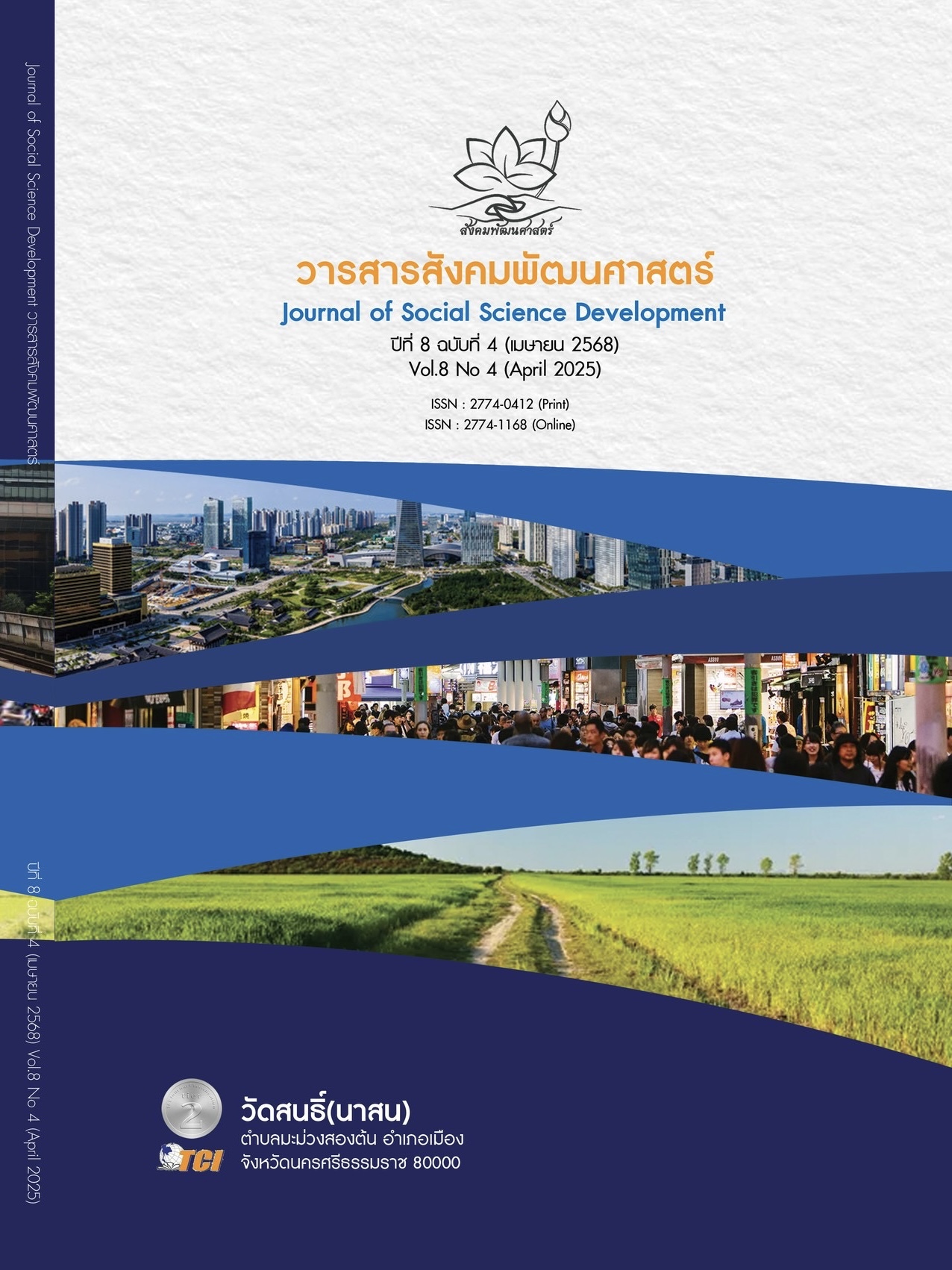การพัฒนาทักษะการอ่านภาษาอังกฤษเพื่อความเข้าใจเชิงธุรกิจโดยการเรียนแบบกลุ่มร่วมมือการเรียนรู้ด้วยเทคนิค STAD (Student Teams Achievement Divisions) ของนักเรียนศึกษาโปรแกรมวิชาโลจิสติกส์ ชั้นปีที่ 2
Main Article Content
บทคัดย่อ
การวิจัยครั้งนี้มีจุดประสงค์เพื่อ 1) เปรียบเทียบผลสัมฤทธิ์การเรียนรู้ทักษะการอ่านภาษาอังกฤษเพื่อความเข้าใจเชิงธุรกิจก่อนและหลังเรียนโดยการเรียนแบบกลุ่มร่วมมือการเรียนรู้เทคนิค STAD (Student Team Achievement Divisions) ของนักศึกษาโปรแกรมวิชาโลจิสติกส์ ชั้นปีที่ 2 2) ศึกษาความพึงพอใจของนักศึกษาโปรแกรมวิชาโลจิสติกส์ ชั้นปีที่ 2 ที่มีต่อการพัฒนาทักษะการอ่านภาษาอังกฤษเพื่อความเข้าใจเชิงธุรกิจโดยการเรียนแบบกลุ่มร่วมมือการเรียนรู้ด้วยเทคนิค STAD กลุ่มตัวอย่างในการศึกษาครั้งนี้ ได้แก่ นักศึกษาโปรแกรมวิชาโลจิสติกส์ ชั้นปีที่ 2 มหาวิทยาลัยราชภัฏกำแพงเพชร แม่สอด ภาคการศึกษาที่ 2 ปีการศึกษา 2567 จำนวน 26 คน ซึ่งคัดเลือกมาโดยวิธีการสุ่มแบบเจาะจง (Purposive sampling) เครื่องมือที่ใช้ในการศึกษานี้ 1) แบบทดสอบทักษะการอ่านภาษาอังกฤษเพื่อความเข้าใจเชิงธุรกิจก่อนและหลังเรียน จำนวน 54 ข้อ 2) เอกสารประกอบการเรียนรู้ทักษะการอ่านภาษาอังกฤษเพื่อความเข้าใจโดยใช้เทคนิค STAD จำนวน 13 หัวข้อ และ 3) แบบสอบถามความพึงพอใจต่อการพัฒนาทักษะการอ่านภาษาอังกฤษเพื่อความเข้าใจด้วยการเรียนแบบกลุ่มร่วมมือการเรียนรู้เทคนิค STAD สถิติที่ใช้ในการวิเคราะห์ข้อมูลได้แก่ ค่าเฉลี่ย ส่วนเบี่ยงเบนมาตรฐาน และ T-test (Dependent Sample) ผลการศึกษาพบว่า 1) ผลสัมฤทธิ์ทักษะการอ่านภาษาอังกฤษเพื่อความเข้าใจเชิงธุรกิจของนักศึกษาโปรแกรมวิชาโลจิสติกส์ โดยการเรียนแบบกลุ่มร่วมมือการเรียนรู้เทคนิค STAD มีคะแนนเฉลี่ยหลังเรียนมากกว่าคะแนนก่อนเรียนคือ 38.84 และ 27.64 ตามลำดับ 2) ความพึงพอใจของนักศึกษาที่มีต่อการพัฒนาทักษะการอ่านภาษาอังกฤษเพื่อความเข้าใจโดยใช้การเรียนแบบกลุ่มร่วมมือการเรียนรู้ เทคนิค STAD ในภาพรวมอยู่ในระดับมาก ( = 4.45)
Article Details

อนุญาตภายใต้เงื่อนไข Creative Commons Attribution-NonCommercial-NoDerivatives 4.0 International License.
เอกสารอ้างอิง
ภราดร สุขพันธ์. (2561). การพัฒนาทักษะการสื่อสารภาษาอังกฤษกับความเป็นบัณฑิตในยุคปัจจุบัน. MCU Haripunchai Review, 2(2), 89-100.
มนัสวี ดวงลอย. (2558). ปัจจัยที่มีผลต่อปัญหาในการอ่านภาษาอังกฤษของนักศึกษาของมหาวิทยาลัยเทคโนโลยี ราชมงคลกรุงเทพ. วารสารครุศาสตร์อุตสาหกรรมหาวิทยาลัยเทคโนโลยีราชมงคลธัญบุรี, 3(1), 151-165.
วรารัตน์ เรืองอิน และคณะ. (2563). ผลของการใช้เว็บเควสต์ร่วมกับวิธีสอนแบบร่วมมือโดยวิธีแบ่งกลุ่มคละผลสัมฤทธิ์ทางการเรียนในการพัฒนาการอ่านภาษา อังกฤษเพื่อความเข้าใจของนักเรียนชั้นมัธยมศึกษาปีที่ 3. วารสารนาคบุตรปริทัศน์, 12(1), 109-119.
Aslan Berzener, Ü. & Deneme, S. (2021). The effect of cooperative learning on EFL learners' success of reading comprehension: An experimental study implementing Slavin's STAD method. Turkish Online Journal of Educational Technology-TOJET, 20(4), 90-100.
Boonruk, S. (2019). Problems in business English reading for comprehension of weekend business English students at Phranakhon Rajabhat University. Retrieved March 6, 2025, from https://papers.ssrn.com/sol3/papers.cfm?abstract_id=3438228.
Chalchissa, G. M. (2024). The effect of the Student Team Achievement Division (STAD) learning method on the students’ reading comprehension and attitude: Fresh man students of Oromia Police College in focus. Journal of Science and Sustainable Development, 12(2), 85-96.
Chewarussamee, R. & Torut, B. (2018). Development of a business English reading cooperative learning model to enhance reading comprehension, critical reading skills and business ethic awareness for undergraduate students of the Faculty of Management Science, Silpakorn University. Retrieved March 21, 2025, from http://202.44.135.157/dspace/bitstream/123456789/2597/1/55254906.pdf
Damanik, I. J. & Handayani, M. (2023). The implementation of Student Teams Achievement Division (STAD) technique to improve student’s reading comprehension. Bilingual: Jurnal Pendidikan Bahasa Inggris, 5(1), 1-9.
Davoudi, M. & Yousefi, D. (2015). Comprehension breakdown: A review of research on EFL learners’ reading difficulty and problems. International Journal of Language and Applied Linguistics, 1(1), 58-72.
Grigoryan, S. & Chalabyan, S. (2024). Current issues in teaching reading comprehension for business English. Retrieved March 12, 2025, from https://journals.ysu.am/index.php/foreign-lang/issue/view/vol28_no2_2024.
Jalilifar, A. (2010). The effect of cooperative learning techniques on college students’ reading comprehension. System, 38(1), 96-108.
Johnson, N. J. & Schlick Noe, K. L. (1999). Getting started with Literature Circles. United States of America: Christopher-Gordon Publishers.
Johnson, R. T. & Johnson, D. W. (1994). An overview of cooperative learning. Retrieved March 12, 2025, from http://www.confeyscience.com/uploads/8/9/2/5/8925140/introduction_to_cooperative_learning__cooperative_learning_institute_and_interaction_book_company.pdf
Nguyen, H. T. et al. (2014). Factors affecting English Language Teaching and learning in higher education. English Language Teaching, 7(8), 94-105.
Senatham, S. & Pattamadilok, S. (2022). Development of English reading comprehension skills by using cooperative learning STAD technique for Grade 6 students. Journal of Buddhist Education and Research, 8(1), 124-134.
Souriyavongsa, T. et al. (2013). Factors causes students low English language learning: A case study in the National University of Laos. International Journal of English Language Education, 1(1), 179-192.
Thao, T. Q. & Tham, D. M. (2018). The difficulties in ESP reading comprehension encountered by English-majored students. VNU Journal of Foreign Studies, 34(2), 151-161.
Yanti, N. & Helmi, R. (2023). The implementation of STAD in improving students’ reading skill. Journal of English Teaching and Linguistics, 4(1), 41-48.


